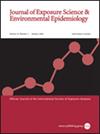Suspect screening of bisphenol A (BPA) structural analogues and functional alternatives in human milk from Canada and South Africa
IF 4.7
3区 医学
Q2 ENVIRONMENTAL SCIENCES
Journal of Exposure Science and Environmental Epidemiology
Pub Date : 2025-06-02
DOI:10.1038/s41370-025-00782-2
引用次数: 0
Abstract
Plastic-related contaminants, such as bisphenols, can enter the maternal body and be transferred to breast milk. While common bisphenols such as bisphenol A, S, F and AF have been detected in previous studies, there is limited knowledge about the occurrence of other structurally similar compounds in human milk with potential endocrine-disrupting properties. In this study, we investigated structural analogues and functional alternatives of bisphenol A (BPA) in 594 human milk samples collected from Canada (Montreal) and South Africa (Vhembe and Pretoria) using LC-Q-TOF-MS through suspect screening. Suspect screening was performed using data collected from the milk samples using a customized database library (204 compounds). A retrospective semi-quantitative approach was then applied to estimate the levels of TGSA, D-8 and D-90 in human milk. This work revealed the presence of eleven compounds, including four compounds commonly used in thermal labels, four ultraviolet filters, and three synthetic antioxidants or metabolites. Retrospective semi-quantification of D-8, D-90 and TGSA revealed levels of up to 1.24, 1.98, and 0.72 ng/mL in milk, respectively. Several structural analogues and functional alternatives of bisphenol A were identified in human milk through non-targeted screening. Two other phenolic compounds (Irganox 1010 and BHT-COOH) were identified in human milk for the first time. This study highlights the importance of novel strategies in human milk biomonitoring to identify emerging contaminants to which breastfeeding infants are exposed.

加拿大和南非母乳中可疑双酚A (BPA)结构类似物和功能替代品的筛选。
背景:与塑料有关的污染物,如双酚类物质,可以进入母体并转移到母乳中。虽然在以前的研究中已经检测到常见的双酚类物质,如双酚A、S、F和AF,但对母乳中存在的其他结构类似的具有潜在内分泌干扰特性的化合物的了解有限。目的:采用LC-Q-TOF-MS对加拿大(蒙特利尔)和南非(Vhembe和比勒陀利亚)的594份母乳样品中双酚A (BPA)的结构类似物和功能替代品进行了研究。方法:使用定制的数据库库(204种化合物)从牛奶样品中收集数据进行可疑筛选。然后采用回顾性半定量方法估计人乳中TGSA、D-8和D-90的水平。结果:共发现11种化合物,包括4种常用的热标签化合物、4种紫外线滤光剂和3种合成抗氧化剂或代谢物。牛奶中D-8、D-90和TGSA的回顾性半定量分析显示,其含量分别高达1.24、1.98和0.72 ng/mL。影响声明:通过非靶向筛选,在母乳中发现了双酚A的几种结构类似物和功能替代品。另外两种酚类化合物(Irganox 1010和BHT-COOH)首次在母乳中被鉴定出来。这项研究强调了在母乳生物监测中识别母乳喂养婴儿暴露的新污染物的新策略的重要性。
本文章由计算机程序翻译,如有差异,请以英文原文为准。
求助全文
约1分钟内获得全文
求助全文
来源期刊
CiteScore
8.90
自引率
6.70%
发文量
93
审稿时长
3 months
期刊介绍:
Journal of Exposure Science and Environmental Epidemiology (JESEE) aims to be the premier and authoritative source of information on advances in exposure science for professionals in a wide range of environmental and public health disciplines.
JESEE publishes original peer-reviewed research presenting significant advances in exposure science and exposure analysis, including development and application of the latest technologies for measuring exposures, and innovative computational approaches for translating novel data streams to characterize and predict exposures. The types of papers published in the research section of JESEE are original research articles, translation studies, and correspondence. Reported results should further understanding of the relationship between environmental exposure and human health, describe evaluated novel exposure science tools, or demonstrate potential of exposure science to enable decisions and actions that promote and protect human health.

 求助内容:
求助内容: 应助结果提醒方式:
应助结果提醒方式:


